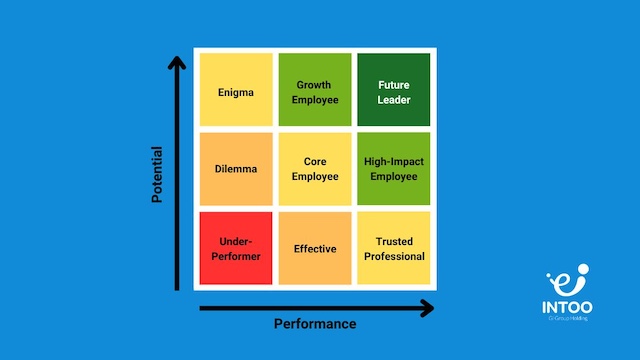Your organization’s future depends on cultivating the right talent. Yet, identifying and nurturing high-potential employees can feel like navigating a dense forest. That’s where the 9-box grid, a powerful talent management tool, shines a bright light.
The 9-box succession planning grid is essentially a matrix that maps employee performance against their future potential. Consider it a talent landscape, neatly segmented into nine squares based on two axes: current performance (below, meeting, and exceeding expectations) and potential (low, medium, and high). At its core, it plots individuals on a chart based on their current performance levels and potential for future company growth. It’s a snapshot that aids in understanding the talent pool and helping leaders make informed decisions about employee development, succession planning, and overall talent strategy.
Building a succession plan? Use this framework.
5 Benefits of Using a 9-Box Grid
The 9-box grid is an invaluable tool in talent management and succession planning, offering several key benefits:
1. Holistic talent assessment
The 9-box grid provides a structured framework to assess an employee’s performance and potential objectively. Plotting individuals along two axes—often current performance and future potential—offers a nuanced view beyond a single-dimensional appraisal. This holistic assessment aids in identifying strengths, weaknesses, and developmental needs, fostering a more well-rounded understanding of an employee’s contribution and prospects within the organization.
Employees with high potential but underwhelming performance may be overlooked without this systematic assessment. By identifying these individuals and providing targeted development opportunities, you can unlock their talents, boost their performance, and expand your pool of future leaders.
2. Strategic succession planning
The 9-box assessment grid facilitates proactive succession planning by highlighting which employees are ready to step into key roles and which may require additional development. Mapping employees’ potential against their performance levels allows organizations to pinpoint their star employees and groom future leaders. These individuals are prime candidates for leadership roles and are critical to your succession planning. By intentionally developing their leadership skills and providing mentorship, you ensure a seamless transition as key positions open up, maintaining organizational stability and growth.
3. Increased employee engagement and retention
When employees see a transparent system for career progression and recognize that their development is taken seriously, they tend to be more engaged and committed to the organization. The 9-box succession planning grid enables tailored development plans for employees based on their placement within the matrix. High performers with high potential can be earmarked for leadership programs or stretch assignments, nurturing their growth within the organization. Meanwhile, those needing improvement in either performance or potential can receive targeted coaching and development opportunities. This personalized approach to talent development enhances employee engagement, satisfaction, and retention.
4. Objective evaluation and reduced bias
The 9-box grid minimizes subjective biases that can influence performance evaluations by utilizing predetermined criteria and standardized measures. This structured evaluation process fosters fairness and consistency across assessments, ensuring that decisions related to talent management are based on objective data rather than personal preferences or perceptions. When employees understand how they are perceived in terms of performance and potential, it sparks meaningful conversations about their strengths, development areas, and career aspirations. This transparency fosters trust, enhances engagement, and promotes a culture of growth and development, leading to higher retention rates.
5. Improved communication and consensus
The 9-box grid offers a straightforward visual representation that creates a shared language for discussing talent among different groups like HR, managers, and executives. Mapping employees on consistent metrics like performance and potential builds an understanding of development needs and succession planning across departments. This alignment of priorities and goals facilitates communication, consensus-building, and a unified strategy regarding where to invest resources to nurture future leaders while meeting current objectives. The clarity and simplicity of the grid boost talent management cohesion across the organization.

How to Create a 9-Box Grid
Creating a successful 9-box grid involves several steps to assess talent accurately. Begin by defining the axes that represent performance and potential. Then, break down what constitutes high and low performance and potential. For instance, performance might be evaluated using metrics like past achievements, sales numbers, quality standards, or competency ratings. The potential could encompass leadership capabilities, learning agility, adaptability to change, and critical thinking skills.
With the axes defined, managers can slot individual employees into the boxes based on evidence supporting their assessment. For example, an employee with consistently top sales but difficulty leading projects may be placed in the “Trusted Professional” box—with high performance but low potential. On the other hand, an employee with excellent strategic thinking but average sales may be deemed a “Growth Employee” with high potential but lower current impact.
Calibration across the leadership team is critical so standards are applied evenly by different managers during the evaluation process. Blind evaluations can reduce unconscious bias. Tying evaluations directly to examples and outcomes for each employee also improves accuracy.
This process, when implemented effectively, results in an integrated and calibrated understanding of the talent landscape. The visual representation makes it easy to diagnose development needs and craft strategies to leverage top talent while lifting the capabilities of average and lower performers. With ongoing rigor and discipline, the 9-box approach can be a game-changer for organizations.
How to Use the 9-Box Grid for Succession Planning
Here’s how to harness the 9-box assessment grid for effective succession planning:
1. Identify future leaders
Focus on employees in the top-right box who demonstrate both high performance and high potential. These individuals are your prime candidates for future leadership roles.
2. Develop succession plans
Create tailored development plans for these high-potential employees, including leadership training, mentorship, and stretch assignments. These plans accelerate their growth and prepare them for smooth transitions into key positions.
3. Address performance gaps
For employees in lower-performing boxes, assess the reasons behind their performance and consider appropriate interventions. Such interventions may include performance improvement plans, redeployment to roles better suited to their strengths, or, in some cases, separation.
4. Reassess regularly
Update the grid periodically as employees develop and organizational needs shift. This ensures your succession plans remain relevant and your talent pipeline stays robust.
5. Transparency and communication
Engage employees in discussions about their placement on the grid and their development opportunities. This transparency fosters trust, engagement, and retention of your top talent. Help your employees take charge of their careers.
Download these tips to make career development conversations more meaningful.
Conclusion
The 9-box grid isn’t just a matrix; it’s also a compass guiding you to navigate the intricate map of your talent pool. It unveils hidden gems—high-potential individuals whose brilliance might otherwise remain veiled beneath layers of routine tasks. It fosters informed decision-making, equipping you to nurture future leaders, bridge performance gaps, and unlock the full potential of your workforce.
If you’re looking for ways to develop all levels of your workforce, including future leaders, INTOO can help. Our career development programming—career coaching, training, and workshops—can be an integral part of your succession planning process. Contact us to learn more today.











